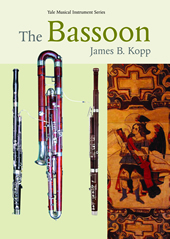Allegro
‘Mystifying instrument’
A new history of the bassoon is an essential text
Volume 113, No. 6June, 2013
 James B. Kopp’s “The Bassoon” (Yale University Press) exemplifies the quality we have come to expect from the Yale Musical Instrument Series. As a comprehensive monograph about the instrument from its early precursors to its use in the modern orchestra, “The Bassoon” is an essential text for those interested in the instrument’s history and development as well as organology in general. The book comes as an outgrowth of Kopp’s relationship and work with William Waterhouse, who was originally a co-author before his passing. Kopp combines a thorough historical review with practical information, and the chapter organization is such that one can easily read from cover to cover and then return to it as a reference. There are ample illustrations, photographs, and examples that elucidate the technical details Kopp presents.
James B. Kopp’s “The Bassoon” (Yale University Press) exemplifies the quality we have come to expect from the Yale Musical Instrument Series. As a comprehensive monograph about the instrument from its early precursors to its use in the modern orchestra, “The Bassoon” is an essential text for those interested in the instrument’s history and development as well as organology in general. The book comes as an outgrowth of Kopp’s relationship and work with William Waterhouse, who was originally a co-author before his passing. Kopp combines a thorough historical review with practical information, and the chapter organization is such that one can easily read from cover to cover and then return to it as a reference. There are ample illustrations, photographs, and examples that elucidate the technical details Kopp presents.
At the outset, Kopp introduces us to this “mystifying instrument,” which had a complex development and has persisted throughout many centuries. As he describes the invention of the early bassoon, his presentation of the history is in no way reductive, striving instead to demythologize its creation so that it is not understood as a direct evolution from a primitive to an ideal form. He explains that the “bassoon idea” was a complex combination of various features that are also present in other similar instruments.
After presenting a background of early precursors, Kopp deals with the bassoon idea in terms of each incarnation of an instrument in the bassoon family. Beginning with the dulcian and cousins like the shawm and racket, he introduces the many iterations of related instruments. He then brings the reader to two chapters on the more familiar baroque and classical models, which were closely related. One especially helpful aspect to the organization in these first few chapters are the subsections that discuss the national differences in the use of the instruments as well as details about makers, composers, repertory, players, and pedagogues. For example, he goes into detail about how composers such as Rameau, Bach, Mozart, Haydn and Beethoven employed the instrument in their works, and he discusses the careers of performers like Ritter, Pfeiffer, Bärmann and Ozi.
For those interested primarily in the history of the modern instrument – and Heckel bassoons in particular – Kopp provides an extensive review of Carl Almenräder’s improvements and the development of the Heckel system in the chapter “The Scientific Bassoon, c. 1830-1900.” He traces Almenräder’s relationship with Johann Adam Heckel and his son Wilhelm Heckel’s innovations. In addition, Kopp includes an overview of the reform models of the nineteenth century. Then, in a chapter titled “A Tale of Two Systems, 1900-1990” he surveys the French and German schools of instruments and playing styles, focusing on Buffet Crampon and Heckel. To round off the history of the modern bassoon, Kopp comments on the changing world for performers in the last 20 years, especially with respect to internationalization and the proliferation of digital media. He argues that from the 1990s the different national styles of bassoon playing began to homogenize into one ideal sound based around the Heckel model. Concurrently, the revival of early bassoons, which had begun in the decades before, really took off.
Kopp then addresses the development of the contrabassoon in its own chapter, beginning with low-pitched dulcians. Accompanying the section on the baroque contrabassoon there is a remarkable photograph of an Eichentopf contra that looks like a tall 6.5-foot bassoon. In the penultimate chapter he introduces other instruments that have features common to the bassoon idea, such as the Harmonie-Bass, sarrusophone and contraforte, and the last chapter focuses on smaller sizes of dulcians and bassoons. Finally, in the epilogue he concludes with a helpful summary of the bassoon’s history.
In the end, it seems the only criticism one might have is that “The Bassoon” tends to avoid traditional narratives of a straight-line evolution. But that is, of course, the point. The instrument followed a varied path in its development, and Kopp resists simple explanations, instead describing the intricacies in a delightfully meticulous way, complemented with vivid language and clarifying commentary to make this book as captivating as it is informational
James Massol is an adjunct faculty member in the music history department at the Manhattan School of Music and was a Fulbright scholar to Germany. In addition, he is a bassoonist with the Savannah Philharmonic and performs on modern and period bassoon in New York City.
